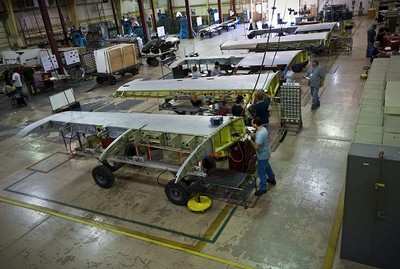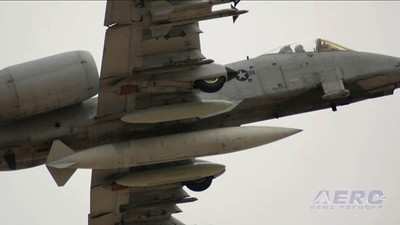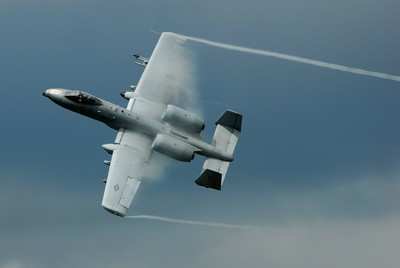Sun, Dec 27, 2009
Mods Will Double Service Life, Allow The Airplane To Carry
Additional Load
The A-10 Thunderbolt II will continue flying
close-ground-support missions for the next two decades because of a
reinforcement process wing replacement specialists call "Hog
Up."

The phrase originated about a decade ago during an upgrade of
the aircraft's avionics system, partially because of the A-10's
"Warthog" nickname. Specialists in the 309th Maintenance Wing's
Aerospace Maintenance and Regeneration Group at Davis-Monthan Air
Force Base and Hill Air Force Base, Utah, install steel straps and
stronger fittings to the wings that give the A-10 an additional
8,000 flying hours and extend the life of the aircraft for another
20 years, said Dave Roe, a 309th AMARG structural engineer.
"The modifications we're giving the wing will double its service
life and allow it to carry the additional load the wings are
expected to carry," Mr. Roe said. "By putting on these additional
straps, we're basically beefing up the structure."

The A-10 is a twin-engine jet aircraft designed for close-air
support of ground forces. Its main use is for ground attack against
tanks, armored vehicles and installations. The aircraft flies with
a range of 800 miles and with high endurance and maneuverability at
low speeds and altitudes that allow accurate targeting and weapon
delivery.
"Nothing else in our inventory can do the job the A-10 can do,
especially in close-ground support," Mr. Roe said. "It also has a
long loiter time over friendlies or over the target if
necessary."
The reinforcements are intended to keep the A-10 fleet flying
until the aircraft receives new wings through a contract awarded to
Boeing in 2007. The contract calls for 242 new wings for
installment on the thin-skinned A-10 airframes by 2011. About 100
A-10 airframes won't need new wings because they were built with a
stronger "thick-skin" structure in the 1980s. Thick-skinned A-10s
were rated for 16,000 flying hours, which should keep them flying
until about 2030. The original A-10s were rated for 8,000 hours,
but were extended with depot repairs in the 1990s. The new wings
should also keep the original A-10s flying through the next 20
years.

"This is an interim fix to keep the A-10s flying while the new
wings are being built," said Daryl Neel, the 309th AMARG center
wing shop supervisor.
More News
“This vote sends an undeniable message to Air Transat management: We are unified, resolute, and have earned a contract that reflects today’s industry standards, not the>[...]
Aero Linx: Beech Aero Club The Beech Aero Club (BAC) is the international type club for owners and pilots of the Beech Musketeer aircraft and its derivatives, the Sport, Super, Sun>[...]
While Landing In The River, The Extended Landing Gear Contacted The Water And The Airplane Nosed Over, Resulting In Substantial Damage Analysis: The pilot of the amphibious airplan>[...]
From 2022 (YouTube Edition): Carrying the Legacy of The B-29 For Generations to Come We had a chance to chat with the Executive Director of B-29 Doc, Josh Wells, during their stop >[...]
Also: Cosmonaut Kicked Out, Airbus Scales Back, AF Silver Star, Russian A-60 Clobbered A Samaritan’s Purse humanitarian flight was hijacked on Tuesday, December 2, while atte>[...]
 Aero-News: Quote of the Day (12.07.25)
Aero-News: Quote of the Day (12.07.25) ANN's Daily Aero-Linx (12.07.25)
ANN's Daily Aero-Linx (12.07.25) NTSB Final Report: Lafferty Jack Sea Rey
NTSB Final Report: Lafferty Jack Sea Rey Classic Aero-TV: The B29 SuperFortress Doc - History in Flight
Classic Aero-TV: The B29 SuperFortress Doc - History in Flight Airborne 12.08.25: Samaritans Purse Hijack, FAA Med Relief, China Rocket Fail
Airborne 12.08.25: Samaritans Purse Hijack, FAA Med Relief, China Rocket Fail





